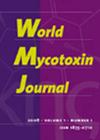Decision support system for integrated management of mycotoxins in feed and food supply chains
IF 1.7
4区 医学
Q3 FOOD SCIENCE & TECHNOLOGY
引用次数: 3
Abstract
Mycotoxins present a global food safety threat of our feed and food. Mycotoxins are toxic metabolites of certain fungi in agricultural products that are harmful to animal and human health. The presence of mycotoxins in these products depends on a variety of management and environmental factors in the field, during storage and/or processing of feed and food commodities. To date, information on mycotoxin management is available, but is not easy to access by supply chain actors. This study aimed to design, build and test a Decision Support System (DSS) that can help decision making on mycotoxin management by various actors along the feed and food supply chains. As part of this, available knowledge and data on mycotoxin prevention and control were collected and synthesised into easy to understand guidelines and tools for various groups of end-users. The DSS consists of four different modules: (a) static information module and (b) scenario analysis module, (c) dynamic module for forecasting mycotoxins, and (d) dynamic module for real-time monitoring of moulds/mycotoxins in grain silos. Intended end-users are all end-user groups for modules (a) and (b); growers and collectors for module (c) and; post-harvest storage managers for module (d). The DSS is user-friendly and accessible through PCs, tablets and smartphones (see https://mytoolbox-platform.com/ ). In various phases of the DSS development, the tool has been demonstrated to groups of end-users, and their suggestions have been taken into account, whenever possible. Also, a near final version has been tested with individual farmers on the easiness to use the system. In this way we aimed to maximise the DSS uptake by actors along the chain. Ultimately, this DSS will improve decision making on mycotoxin management; it will assist in reducing mycotoxin contamination in the key crops of Europe, thereby reducing economic losses and improving animal and human health.饲料和食品供应链真菌毒素综合管理决策支持系统
真菌毒素对我们的饲料和食品构成全球食品安全威胁。真菌毒素是农产品中某些真菌的有毒代谢物,对动物和人类健康有害。这些产品中真菌毒素的存在取决于现场、饲料和食品商品储存和/或加工期间的各种管理和环境因素。迄今为止,有关于霉菌毒素管理的信息,但供应链行为者不易获取。本研究旨在设计、构建和测试一个决策支持系统(DSS),该系统可以帮助饲料和食品供应链上的各个参与者就霉菌毒素管理做出决策。作为这项工作的一部分,收集了关于真菌毒素预防和控制的现有知识和数据,并将其合成为各种最终用户群体易于理解的指南和工具。DSS由四个不同的模块组成:(a)静态信息模块和(b)情景分析模块,(c)用于预测霉菌毒素的动态模块,(d)用于实时监测粮食筒仓中的霉菌/真菌毒素的动态模块。预期最终用户是模块(a)和(b)的所有最终用户组;模块(c)的种植者和收集器;模块(d)的收获后存储管理器。决策支持系统用户友好,可通过个人电脑、平板电脑和智能手机访问(见https://mytoolbox-platform.com/)。在决策支持系统开发的各个阶段,已向最终用户群体展示了该工具,并尽可能考虑到他们的建议。此外,接近最终版本已经在个别农民中测试了该系统的易用性。通过这种方式,我们的目标是最大限度地提高链上参与者对决策支持系统的吸收。最终,该决策支持系统将改善霉菌毒素管理的决策;它将有助于减少欧洲主要作物中的霉菌毒素污染,从而减少经济损失并改善动物和人类健康。
本文章由计算机程序翻译,如有差异,请以英文原文为准。
求助全文
约1分钟内获得全文
求助全文
来源期刊

World Mycotoxin Journal
MYCOLOGY-
CiteScore
4.60
自引率
5.00%
发文量
25
审稿时长
>12 weeks
期刊介绍:
''World Mycotoxin Journal'' is a peer-reviewed scientific journal with only one specific area of focus: the promotion of the science of mycotoxins. The journal contains original research papers and critical reviews in all areas dealing with mycotoxins, together with opinions, a calendar of forthcoming mycotoxin-related events and book reviews. The journal takes a multidisciplinary approach, and it focuses on a broad spectrum of issues, including toxicology, risk assessment, worldwide occurrence, modelling and prediction of toxin formation, genomics, molecular biology for control of mycotoxigenic fungi, pre-and post-harvest prevention and control, sampling, analytical methodology and quality assurance, food technology, economics and regulatory issues. ''World Mycotoxin Journal'' is intended to serve the needs of researchers and professionals from the scientific community and industry, as well as of policy makers and regulators.
 求助内容:
求助内容: 应助结果提醒方式:
应助结果提醒方式:


